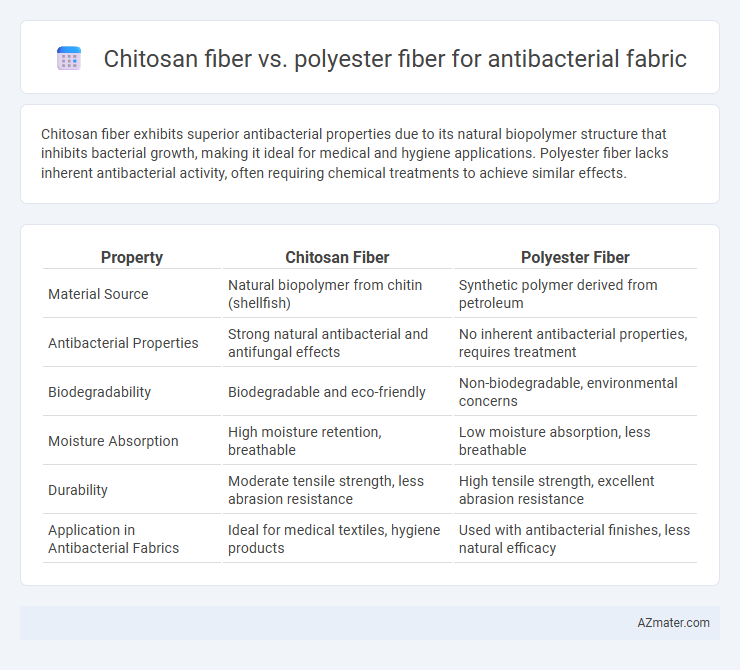Chitosan fiber exhibits superior antibacterial properties due to its natural biopolymer structure that inhibits bacterial growth, making it ideal for medical and hygiene applications. Polyester fiber lacks inherent antibacterial activity, often requiring chemical treatments to achieve similar effects.
Table of Comparison
| Property | Chitosan Fiber | Polyester Fiber |
|---|---|---|
| Material Source | Natural biopolymer from chitin (shellfish) | Synthetic polymer derived from petroleum |
| Antibacterial Properties | Strong natural antibacterial and antifungal effects | No inherent antibacterial properties, requires treatment |
| Biodegradability | Biodegradable and eco-friendly | Non-biodegradable, environmental concerns |
| Moisture Absorption | High moisture retention, breathable | Low moisture absorption, less breathable |
| Durability | Moderate tensile strength, less abrasion resistance | High tensile strength, excellent abrasion resistance |
| Application in Antibacterial Fabrics | Ideal for medical textiles, hygiene products | Used with antibacterial finishes, less natural efficacy |
Introduction to Antibacterial Fabrics
Antibacterial fabrics inhibit the growth of bacteria, reducing odor and enhancing hygiene in textiles. Chitosan fiber, derived from chitin in crustacean shells, naturally exhibits strong antibacterial properties due to its polycationic nature, making it effective against a broad spectrum of bacteria. Polyester fiber, a synthetic polymer, lacks inherent antibacterial properties but can be treated with antimicrobial agents to achieve similar effects, though these treatments may diminish over time compared to the durable, biocompatible activity of chitosan-based fabrics.
Overview of Chitosan Fiber
Chitosan fiber, derived from chitin found in crustacean shells, exhibits natural antibacterial properties due to its polycationic nature, which disrupts microbial cell membranes. Unlike polyester fiber, which requires chemical treatments to achieve antibacterial effects, chitosan fiber inherently inhibits bacterial growth, making it ideal for hygiene-sensitive applications. Its biodegradability and biocompatibility further enhance its suitability for sustainable and skin-friendly antibacterial fabrics.
Overview of Polyester Fiber
Polyester fiber is a synthetic polymer widely used in textile manufacturing due to its durability, wrinkle resistance, and cost-effectiveness. In antibacterial fabric applications, polyester can be treated with antimicrobial agents to inhibit bacterial growth, although it lacks inherent antibacterial properties compared to natural fibers like chitosan. Its hydrophobic nature limits moisture absorption, affecting the overall efficacy of antibacterial treatments on polyester textiles.
Antibacterial Properties: Chitosan vs Polyester
Chitosan fiber exhibits superior antibacterial properties compared to polyester fiber due to its natural biopolymer structure that disrupts bacterial cell membranes and inhibits microbial growth. Polyester fiber lacks intrinsic antimicrobial activity and often requires chemical treatments or additives to achieve similar antibacterial effects. The inherent antimicrobial mechanism of chitosan fiber makes it a preferred choice for durable antibacterial fabrics in medical and hygiene applications.
Mechanisms of Antibacterial Action
Chitosan fiber exhibits antibacterial properties through its positively charged amino groups, which interact with the negatively charged microbial cell membranes, leading to cell membrane disruption and leakage of intracellular components. In contrast, polyester fiber lacks inherent antibacterial activity but can be treated with antimicrobial agents that release biocides or create contact-killing surfaces. The natural biodegradability and biocompatibility of chitosan enhance its effectiveness and safety as an antibacterial fabric compared to chemically modified polyester counterparts.
Durability and Washability
Chitosan fiber exhibits strong antibacterial properties that remain effective even after multiple washes, maintaining durability due to its natural biopolymer structure. Polyester fiber provides excellent mechanical strength and wear resistance but may require chemical treatments to achieve lasting antibacterial effects, which can diminish after repeated laundering. Chitosan's biodegradability and sustained antibacterial activity make it a preferable choice for eco-friendly antibacterial fabrics with reliable washability performance.
Environmental Impact and Biodegradability
Chitosan fiber, derived from natural sources like crustacean shells, offers superior environmental benefits and biodegradability compared to synthetic polyester fiber, which is petroleum-based and non-biodegradable. Chitosan's inherent antibacterial properties reduce the need for harmful chemical treatments, enhancing sustainability in antibacterial fabric production. In contrast, polyester fibers contribute to microplastic pollution and take centuries to decompose, posing significant ecological challenges.
Comfort and Skin Compatibility
Chitosan fiber offers superior comfort and excellent skin compatibility due to its natural origin, breathability, and moisture-wicking properties, making it ideal for antibacterial fabric applications. Polyester fiber, while durable and cost-effective, tends to retain heat and moisture, which can cause discomfort and skin irritation over prolonged wear. The biocompatibility and antimicrobial properties of chitosan fiber enhance its suitability for sensitive skin, positioning it as a preferred choice for antibacterial textiles focused on comfort.
Application Areas in Textile Industry
Chitosan fiber exhibits natural antibacterial properties, making it ideal for medical textiles, sportswear, and hygiene products where infection control and odor resistance are essential. Polyester fiber, often engineered with antibacterial finishes, is widely used in everyday apparel, home textiles, and industrial fabrics due to its durability and cost-effectiveness. The textile industry leverages chitosan fibers predominantly in high-performance and functional textiles, while polyester fibers dominate mass-market applications requiring antibacterial treatments.
Future Prospects and Innovations
Chitosan fiber exhibits strong antibacterial properties due to its natural biocompatibility and biodegradability, positioning it as a sustainable alternative to synthetic polyester fiber in antibacterial fabric applications. Innovations in nanotechnology and fiber blending are advancing the functional performance of chitosan fibers, enhancing durability and antimicrobial efficacy for future medical textiles and wearable health monitors. The rising demand for eco-friendly antimicrobial materials is driving research into scalable production methods and hybrid fibers combining chitosan with polyester to optimize cost, performance, and environmental impact.

Infographic: Chitosan fiber vs Polyester fiber for Antibacterial fabric
 azmater.com
azmater.com